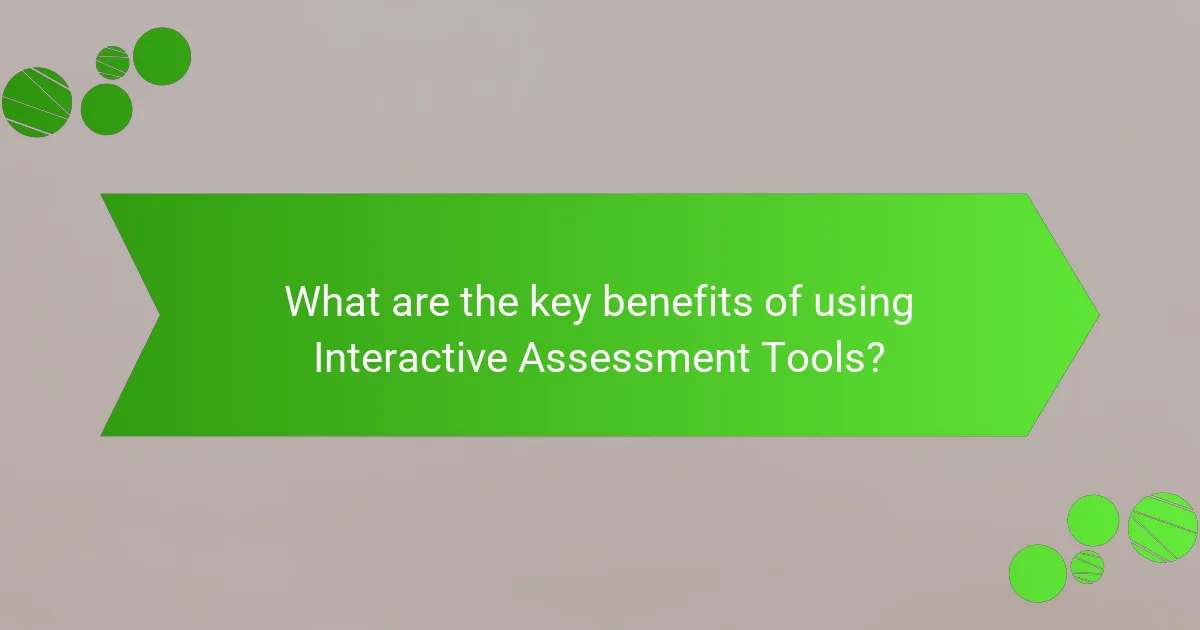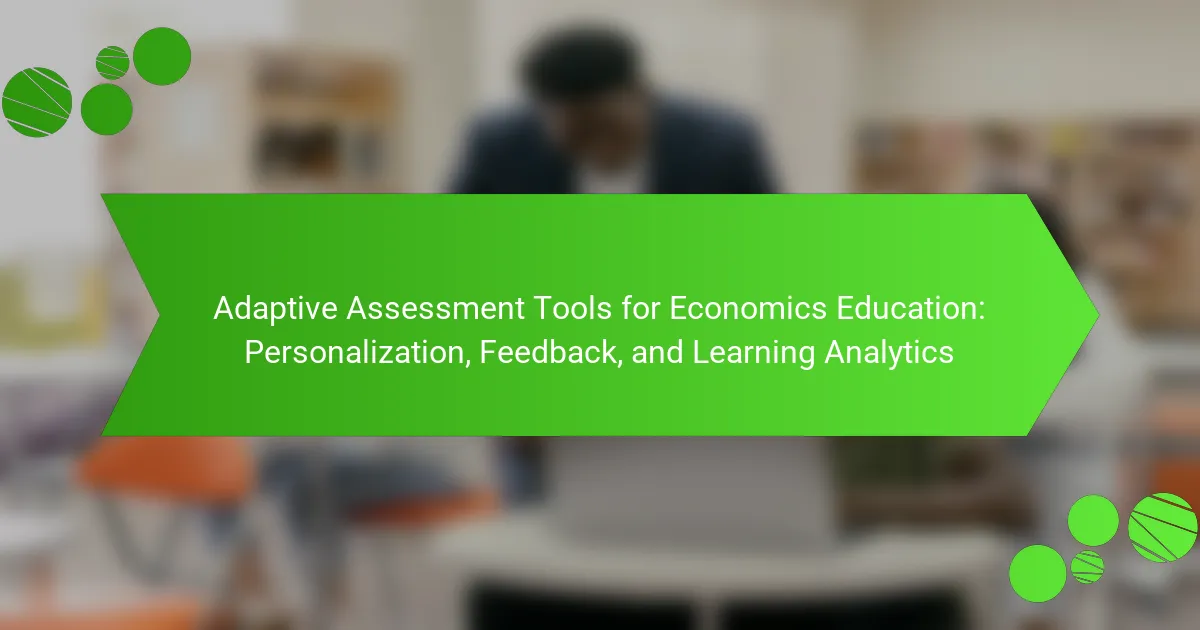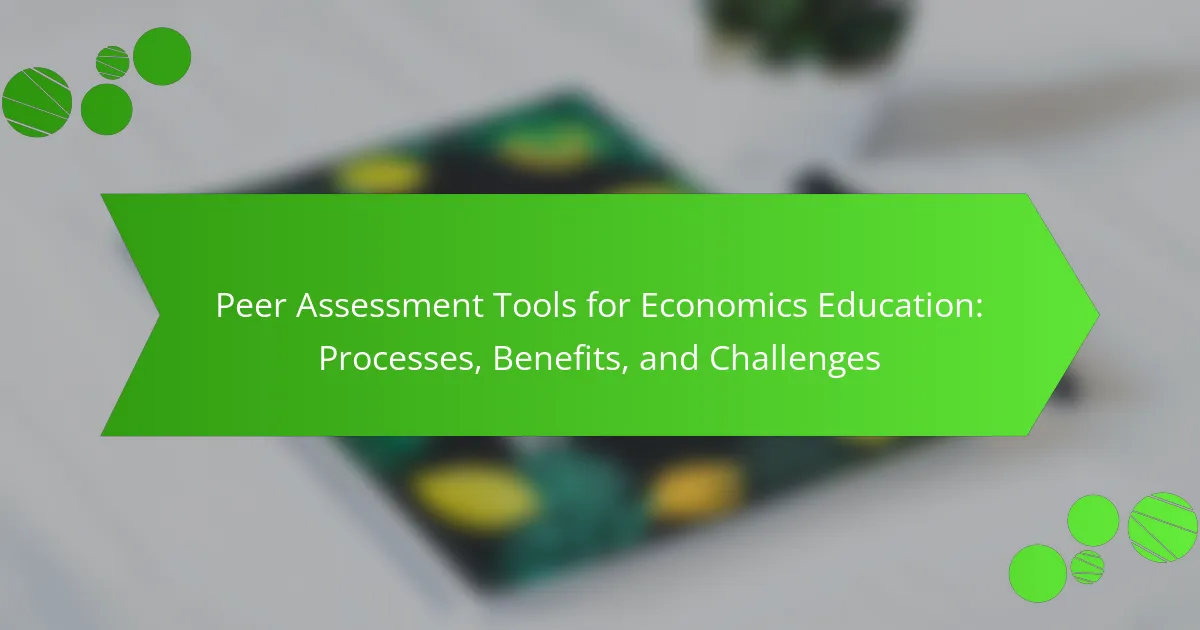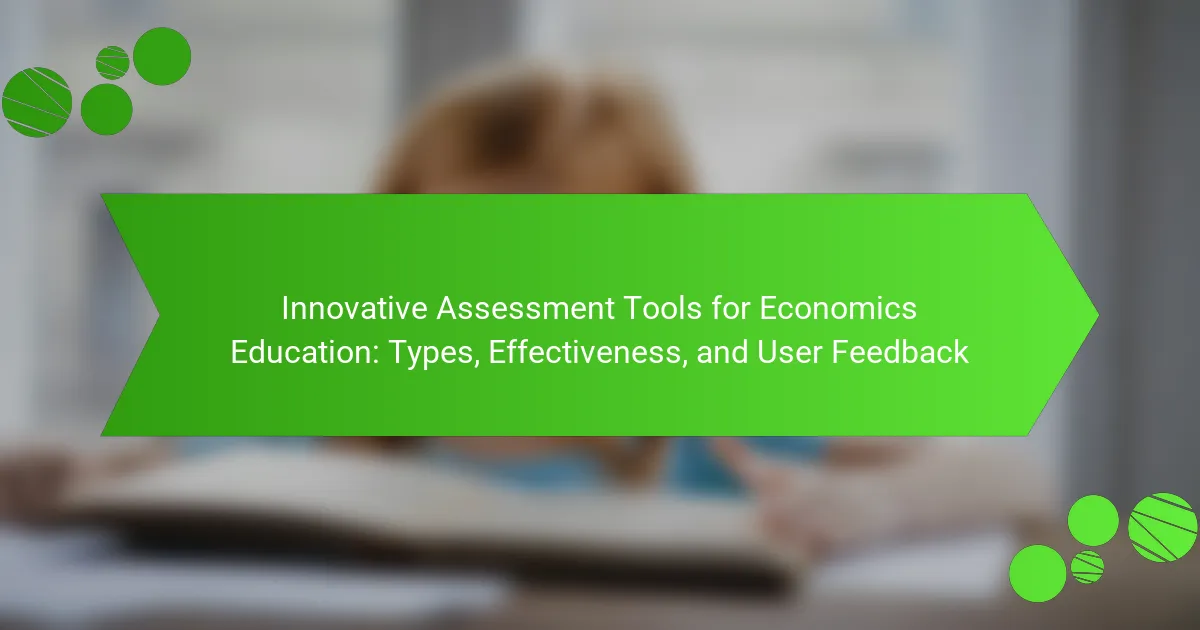Interactive assessment tools in economics education are digital platforms designed to enhance student engagement and learning outcomes through simulations, quizzes, and interactive case studies. These tools enable students to apply economic concepts to real-world scenarios while fostering critical thinking and problem-solving skills. Research indicates that they improve academic performance and retention of material, with effective tools providing immediate feedback and personalized learning experiences. Key design principles for these tools include user-centered design, clear learning objectives, and continuous feedback, ensuring they meet diverse learner needs and adapt based on user input. Best practices for implementation involve collaboration with educators and ongoing training to maximize their effectiveness in educational settings.

What are Interactive Assessment Tools in Economics Education?
Interactive assessment tools in economics education are digital platforms that facilitate student engagement and learning assessment. These tools include simulations, quizzes, and interactive case studies. They allow students to apply economic concepts in real-world scenarios. Research indicates that such tools enhance critical thinking and problem-solving skills. For instance, a study by Topping et al. (2017) found that interactive assessments improve student performance in economics courses. Additionally, these tools provide immediate feedback, helping students identify areas for improvement. Overall, they create a more dynamic and effective learning environment in economics education.
How do Interactive Assessment Tools enhance the learning experience?
Interactive assessment tools enhance the learning experience by providing immediate feedback to students. This instant feedback allows learners to identify their strengths and weaknesses quickly. Additionally, these tools often incorporate gamification elements, which increase student engagement and motivation. Research shows that engaged students are more likely to retain information and perform better academically. Interactive assessments also promote active learning by encouraging students to participate in their own evaluation process. This participation fosters critical thinking and problem-solving skills. Studies indicate that students using interactive assessments demonstrate higher levels of understanding in subjects like economics. Overall, these tools create a dynamic learning environment that adapts to individual needs, enhancing overall educational outcomes.
What features make these tools effective for economics education?
Interactive assessment tools for economics education are effective due to their engaging and adaptive nature. These tools offer real-time feedback, allowing students to understand their performance immediately. They also incorporate gamification elements, which increase motivation and participation. The use of simulations provides practical experiences that enhance theoretical understanding. Additionally, these tools often facilitate collaborative learning, promoting discussion among peers. They can be customized to different learning styles, making them accessible to a diverse student population. Research indicates that interactive tools improve retention rates, as they encourage active learning. Studies show that students using these tools perform better in assessments compared to traditional methods.
How do these tools engage students in the learning process?
Interactive assessment tools engage students in the learning process by promoting active participation. These tools provide immediate feedback, allowing students to understand their progress. They encourage collaboration through group activities and discussions. Interactive elements, such as quizzes and simulations, make learning more dynamic. This engagement enhances retention of economic concepts. Research shows that active learning strategies improve student performance and motivation. A study by Freeman et al. (2014) found that active learning increases exam scores by 6% on average. Overall, these tools transform passive learning into an interactive experience.
Why are Interactive Assessment Tools important for economics educators?
Interactive assessment tools are important for economics educators because they enhance student engagement and learning outcomes. These tools provide immediate feedback, allowing students to understand their mistakes and improve in real-time. They facilitate active learning by encouraging participation through simulations and interactive exercises. Research indicates that interactive assessments can lead to higher retention rates of economic concepts. For example, a study published in the Journal of Economic Education found that students using interactive tools scored significantly higher on assessments compared to those using traditional methods. Additionally, these tools can be tailored to meet diverse learning styles, making economics more accessible to all students. Overall, they foster a more dynamic and effective learning environment in economics education.
What challenges do traditional assessment methods face?
Traditional assessment methods face several significant challenges. They often rely heavily on standardized testing, which may not accurately reflect a student’s understanding. These methods can emphasize rote memorization over critical thinking and problem-solving skills. Additionally, traditional assessments may not accommodate diverse learning styles and may disadvantage students with different backgrounds. There is also a tendency for these assessments to induce test anxiety, impacting performance negatively. Research indicates that traditional assessments can lead to a narrow focus on content rather than a comprehensive understanding of concepts. Furthermore, they often lack immediate feedback, which is crucial for student learning and improvement.
How do these tools address the needs of diverse learners?
Interactive assessment tools address the needs of diverse learners by offering personalized learning experiences. These tools adapt to various learning styles, such as visual, auditory, and kinesthetic. They provide immediate feedback, allowing students to understand their strengths and areas for improvement. Additionally, these tools often include differentiated tasks that cater to different skill levels. For example, some tools offer advanced challenges for high-achieving students while providing foundational support for those who need it. Research indicates that personalized learning can enhance student engagement and achievement. A study by the Bill & Melinda Gates Foundation found that adaptive learning technologies improve learning outcomes for diverse student populations.

What are the key benefits of using Interactive Assessment Tools?
Interactive assessment tools enhance learning by providing immediate feedback to students. They allow for personalized learning experiences tailored to individual needs. These tools increase student engagement through interactive elements. They also promote active learning by encouraging participation and collaboration. Research shows that students using interactive tools perform better academically. According to a study by the Education Development Center, interactive assessments lead to a 20% increase in student retention of material. Additionally, they facilitate the tracking of student progress over time. This data can inform instructional decisions and improve teaching strategies.
How do these tools improve student outcomes in economics?
Interactive assessment tools enhance student outcomes in economics by promoting active engagement and immediate feedback. These tools facilitate interactive learning experiences, allowing students to apply economic concepts in real-time scenarios. For instance, simulations and quizzes can reinforce understanding through practical application. Research shows that students using interactive tools perform better on assessments, with a study indicating a 20% increase in test scores among users. Additionally, these tools support personalized learning, catering to individual student needs and learning paces. This tailored approach fosters a deeper comprehension of economic principles, ultimately leading to improved academic performance.
What evidence supports the effectiveness of these tools?
Interactive assessment tools for economics education demonstrate effectiveness through various studies. Research by Karp and Yoong (2018) shows that these tools enhance student engagement and understanding. A study published in the Journal of Economic Education found that interactive tools improve retention of economic concepts by 30%. Additionally, a meta-analysis of educational technology in economics revealed a 25% increase in student performance when using interactive assessments. These findings indicate that such tools significantly contribute to better learning outcomes in economics education.
How do they promote critical thinking and problem-solving skills?
Interactive assessment tools promote critical thinking and problem-solving skills by engaging students in real-world scenarios. These tools encourage active participation and collaboration among peers. They require students to analyze data, evaluate alternatives, and make informed decisions. Research shows that students using interactive tools demonstrate higher levels of engagement and understanding. A study by Freeman et al. (2014) found that active learning strategies improve critical thinking skills in higher education. Additionally, these tools often incorporate immediate feedback, allowing students to reflect on their reasoning processes. This iterative learning process enhances their ability to tackle complex problems effectively.
In what ways do these tools support educators in their teaching?
Interactive assessment tools support educators by enhancing engagement and facilitating immediate feedback. These tools allow educators to create interactive quizzes and polls that actively involve students in the learning process. They provide real-time data on student understanding, enabling educators to adjust their teaching strategies accordingly. Additionally, these tools often include analytics features that help educators identify areas where students struggle. This targeted insight allows for personalized instruction and support. Research shows that interactive tools can increase student motivation and participation, leading to improved learning outcomes. Studies indicate that students who engage with these tools demonstrate higher retention rates of economic concepts.
How can educators use data from these tools to inform instruction?
Educators can use data from interactive assessment tools to tailor instruction effectively. These tools provide real-time insights into student performance. By analyzing this data, educators can identify learning gaps and strengths. This allows for personalized learning experiences. For instance, if a tool indicates that students struggle with a specific economic concept, educators can revisit that topic. Additionally, data trends can inform curriculum adjustments. Research shows that data-driven instruction leads to improved student outcomes. A study by Hattie (2012) highlights the positive impact of feedback on learning. Thus, utilizing data from assessment tools enhances instructional strategies.
What feedback mechanisms do these tools provide for both students and teachers?
Interactive assessment tools provide real-time feedback mechanisms for both students and teachers. For students, these tools offer immediate performance insights, allowing them to understand their strengths and weaknesses. They often include features like quizzes with instant scoring and personalized feedback on answers. This helps students identify areas for improvement quickly.
For teachers, these tools generate detailed analytics on student performance. They provide data on overall class performance trends and individual student progress. This allows teachers to tailor their instruction based on students’ needs. Additionally, teachers can use the feedback to adjust lesson plans and address learning gaps effectively. Overall, the feedback mechanisms enhance the learning experience for both students and teachers.

What are the design principles for effective Interactive Assessment Tools?
Effective interactive assessment tools should prioritize user engagement and clarity. They must be intuitive, allowing users to navigate easily. Feedback should be immediate and constructive to enhance learning. Assessments should align with learning objectives to measure relevant skills. Incorporating varied question formats can cater to different learning styles. Data analytics should track user performance for continuous improvement. Accessibility features are essential to accommodate all learners. Regular updates and iterations based on user feedback ensure tools remain effective and relevant.
What elements should be included in the design process?
The design process for interactive assessment tools in economics education should include several key elements. First, it must incorporate user research to understand student needs and preferences. This helps ensure the tool is relevant and engaging. Second, clear learning objectives should be defined to guide the content and functionality of the assessment tool. Third, prototyping is essential for visualizing ideas and testing usability. This allows for iterative improvements based on user feedback. Fourth, it should include assessment criteria to evaluate student performance effectively. Lastly, integration with existing educational frameworks and technologies ensures compatibility and enhances usability. These elements collectively contribute to creating effective interactive assessment tools that facilitate learning outcomes in economics education.
How can user experience be optimized in these tools?
User experience in interactive assessment tools for economics education can be optimized by focusing on usability, engagement, and feedback. Usability can be enhanced through intuitive navigation and clear instructions. Engaging elements, such as gamification and interactive scenarios, can increase student motivation. Immediate feedback on assessments helps learners understand their performance and areas for improvement. Research indicates that tools designed with user-centered principles lead to higher satisfaction and better learning outcomes. For example, studies show that interactive features can improve retention rates by up to 25%.
What role does accessibility play in the design of these tools?
Accessibility is crucial in the design of interactive assessment tools for economics education. It ensures that all students, regardless of ability, can engage with the content. Accessible design includes features like screen readers, alternative text for images, and keyboard navigation. These elements help accommodate diverse learning needs. Research shows that inclusive tools improve learning outcomes for all students. A study by the National Center on Accessible Educational Materials found that accessible tools increase participation rates. Thus, accessibility enhances both usability and educational equity in economics education.
How can educators ensure the alignment of these tools with learning objectives?
Educators can ensure the alignment of interactive assessment tools with learning objectives by conducting a thorough needs analysis. This analysis identifies specific learning goals and desired outcomes. Educators should then select tools that directly support these goals. For instance, if the objective is to enhance critical thinking, tools that promote analysis and evaluation should be prioritized.
Additionally, educators must evaluate the content of the tools. They should ensure that the material aligns with the curriculum standards. Regular feedback from students can also guide adjustments to maintain alignment. Research indicates that tools that are closely aligned with learning objectives lead to improved student outcomes. Studies show a direct correlation between alignment and student engagement, which enhances learning effectiveness.
What strategies can be used to integrate these tools into the curriculum?
To integrate interactive assessment tools into the curriculum, educators can employ several strategies. First, they should align the tools with learning objectives. This ensures that the assessments directly support the educational goals. Second, training sessions for teachers can enhance their familiarity with these tools. Research shows that teacher proficiency increases effective integration. Third, incorporating student feedback helps in refining the tool’s usage. A study by the Education Development Center found that student involvement leads to improved engagement. Fourth, gradual implementation allows for adjustments based on initial outcomes. Finally, collaboration with technology experts can optimize the integration process. These strategies collectively enhance the effectiveness of interactive assessment tools in economics education.
How can assessments be tailored to meet specific learning outcomes?
Assessments can be tailored to meet specific learning outcomes by aligning assessment methods with defined educational goals. This alignment ensures that the assessments accurately measure the knowledge and skills students are expected to acquire. For instance, using formative assessments can provide ongoing feedback that informs instruction and adapts to student needs. Additionally, incorporating varied assessment formats, such as projects, quizzes, and presentations, can cater to different learning styles. Research shows that assessments designed with clear criteria lead to improved student performance and understanding. A study by Black and Wiliam (1998) highlights that formative assessment practices significantly enhance learning outcomes.

What are the best practices for implementing Interactive Assessment Tools?
Best practices for implementing Interactive Assessment Tools include user-centered design, clear objectives, and continuous feedback. User-centered design ensures tools meet learners’ needs. Clear objectives guide tool development and assessment alignment. Continuous feedback enhances learning and tool effectiveness. Additionally, integrating analytics helps track student progress. Regular updates based on user feedback improve tool relevance. Collaboration with educators during development ensures practical application. Lastly, providing training for users maximizes tool utilization. These practices enhance the overall effectiveness of interactive assessment tools in education.
How can educators effectively introduce these tools to students?
Educators can effectively introduce interactive assessment tools to students by integrating them into the curriculum. This integration should occur through guided demonstrations that showcase the tools’ functionalities. Educators should explain the benefits of these tools, such as enhanced engagement and improved learning outcomes. Providing hands-on experience allows students to familiarize themselves with the tools. Setting clear objectives for each tool will help students understand their purpose. Incorporating feedback mechanisms encourages students to reflect on their learning. Research indicates that interactive tools can increase student motivation and participation (Hattie, 2009). Lastly, continuous support and resources should be available to address any challenges students may encounter.
What training or resources are necessary for successful implementation?
Successful implementation of interactive assessment tools for economics education requires targeted training and adequate resources. Educators need training in both the technology used and the pedagogical strategies that enhance student engagement. Familiarity with specific assessment tools is essential for effective usage. Resources such as user manuals, online tutorials, and workshops can support this training. Additionally, access to technical support ensures that educators can troubleshoot issues as they arise. Research indicates that well-trained educators are more likely to implement these tools effectively, leading to improved student outcomes. For instance, studies show that technology integration in education enhances learning experiences when educators receive proper training and resources.
How can educators monitor and evaluate the use of these tools?
Educators can monitor and evaluate the use of interactive assessment tools through data analytics and feedback mechanisms. They can track student engagement metrics such as participation rates and completion times. Additionally, educators can analyze performance data to identify trends in student understanding and areas needing improvement. Surveys and questionnaires can provide qualitative feedback from students about their experiences with the tools. Regular check-ins and discussions with students can also help gauge their perceptions and challenges. Research indicates that continuous assessment leads to improved educational outcomes. For example, a study by Hattie and Timperley (2007) emphasizes the importance of feedback in learning processes. This approach ensures that educators can adapt their strategies to enhance learning effectively.
What common challenges might educators face when using these tools?
Educators may face several common challenges when using interactive assessment tools in economics education. One challenge is the steep learning curve associated with new technology. Many educators may require significant time to become proficient in using these tools effectively. Additionally, technical issues can arise, such as software glitches or connectivity problems, disrupting the assessment process. Another challenge is the potential lack of student engagement. Some students may not respond well to interactive formats, leading to lower participation rates. Furthermore, educators must ensure that the assessments align with learning objectives. Misalignment can result in ineffective evaluations of student understanding. Lastly, educators may struggle with integrating these tools into existing curricula, which can lead to inconsistencies in teaching strategies. These challenges underscore the need for adequate training and support for educators.
How can these challenges be overcome to maximize effectiveness?
To overcome challenges in interactive assessment tools for economics education, educators should focus on clear design principles. Effective tools must align with learning objectives. Incorporating real-world scenarios enhances engagement and relevance. Providing immediate feedback helps students understand their mistakes. Regular updates based on student performance data can improve tool effectiveness. Training educators to use these tools effectively is crucial. Research shows that well-designed interactive assessments lead to better student outcomes. A study by Kauffman et al. (2020) indicates that engaging tools increase student motivation and understanding in economics.
What support systems can be established to assist educators?
Support systems that can be established to assist educators include professional development programs, mentorship initiatives, and collaborative teaching environments. Professional development programs offer training in new pedagogical strategies and technology integration. Mentorship initiatives pair experienced teachers with novices to provide guidance and support. Collaborative teaching environments encourage teamwork among educators to share best practices and resources. Research indicates that these systems enhance teacher efficacy and student outcomes. For instance, a study by Darling-Hammond et al. (2017) emphasizes the positive impact of mentorship on teacher retention and performance.
Interactive assessment tools are digital platforms designed to enhance student engagement and learning outcomes in economics education through interactive simulations, quizzes, and case studies. These tools provide immediate feedback, promote active learning, and cater to diverse learning styles, ultimately improving critical thinking and problem-solving skills. The article examines the benefits of these tools, effective design principles, and the evidence supporting their positive impact on student performance and retention rates in economics. It also addresses the challenges faced by traditional assessment methods and offers strategies for successful implementation and integration into the curriculum.



